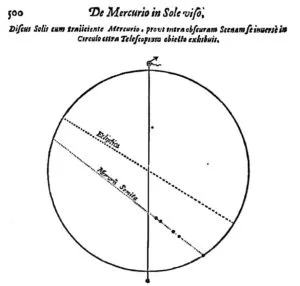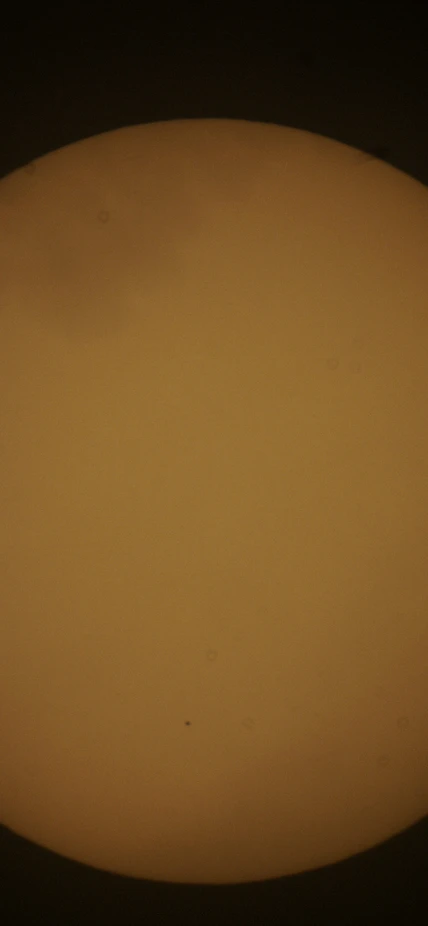Written by former postdoc Tri Astraatmadja
In astronomical parlance, a transit is a celestial phenomenon in which an object passes between us---the observer---in front of a larger object. A transit of Mercury, in which Mercury passes in front of the Sun, is an example of such phenomena that took place on November 11th, 2019 between 7:35 AM EST until 1:04 PM EST.
DTM’s postdoctoral fellow Tri Astraatmadja (left) set up a telescope willed to DTM by our former staff astronomer John Graham to observe the small spot as Mercury passed between Earth and the Sun. Credit: Shaun Hardy
Transits of Mercury are relatively rare events. On average there are about 13 or 14 transits per century, either in May or November. They also usually come in pairs separated by 3 years, with each pair separated by about a decade. Before this 2019 edition, the previous transits occurred in 2016, 2006, and 2003. The next one will happen on November 13th, 2032 (mark your calendar!). Such is the regularity of our Solar System.
Mercury's apparent size is about 150 times smaller than the Sun. Observing the transit is thus a rather challenging affair: Not only do we need a solar filter to safely observe the Sun, but also a good magnification. For this we can use a telephoto lens or a telescope.
Kepler Predicts the Mercury Transit
In 1627, Johannes Kepler had just finished his star catalogue and planetary tables, allowing him to predict the future positions of the planets with great accuracy. He predicted that Mercury would pass in front of the Sun on November 7, 1631. He died in 1630, never witnessing his predictions. However, French astronomer and Catholic priest Pierre Gassendi got wind of Kepler's prediction and started to make preparations. He observed the transit in a darkened room by projecting the image of the Sun through his Galilean telescope. Initially, he thought he was seeing a sunspot because Mercury is so tiny compared to the size of the solar disc!

Pierre Gassendi's observation of the 1631 transit of Mercury. Credit: Pierre Gassendi from scientus.org
Gassendi expected a much larger size because Kepler had predicted that Venus' diameter is almost a quarter of the Sun's diameter, so presumably, Mercury should have a tenth of the Sun's diameter. With the telescope having just been invented and the position of the Earth in the Solar System still a matter of debate, the size of planets was anybody's guess. Luckily he kept observing and managed to convince himself that he was indeed seeing Mercury, having noted that its movement across the Sun was so rapid, it could not be a sunspot. Thus Pierre Gassendi, along with two other people, became the first known humans to observe a transit of Mercury. Only Gassendi, however, wrote about his observations and therefore revealed for the first time the size of a planet compared to the Sun.
Halley's 100 Year Plan
Edmond Halley (of comet fame) was another astronomer inspired by the transit of Mercury after observing the 1677 transit from the island of Saint Helena (where Napoleon was famously exiled). He was inspired by Scottish mathematician James Gregory's idea that a transit observed at two different places on Earth would have different durations due to the different vantage point. At that time we already knew the distances of the planets from the Sun relative to the distance of the Earth from the Sun, but we didn't know the actual distance of the Earth from the Sun. By measuring these two different durations and knowing the distance between these two places, we could, with a bit of trigonometry, determine the distance from the Earth to the Sun for the first time!
In a paper published in 1716, Halley called for a global campaign of measuring the duration of future transits, particularly the upcoming 1761 transit of Venus. Because Venus is much bigger than Mercury, its transit across the Sun would be much more dramatic and could be seen without a telescope! Measurements of its starting and ending time would be more accurate as well. However, transits of Venus are very rare: They only come in pairs eight years apart, and the pairs are separated by 121.5 and 105.5 years. Nevertheless, expeditions were launched to observe the transits of 1761, 1769, 1874, and 1882.
Because of the long gaps between transits, each transit was observed by a different generation of scientists and explorers. Each new generation had access to upgraded optical and timing technology, each time refining the value of the distance from the Sun to the Earth (known as the Astronomical Unit or AU for short). Since then better techniques have been developed to calculate the value of the Astronomical Unit with greater accuracy, using radar ranging to Venus and other planets in addition to other methods.
Exoplanet Explorers
Transits of Mercury and Venus these days are more interesting as a popular introduction to the beauty of astronomy and for amateur astronomers to test their instruments and skills. Nevertheless, transits still play an important role in astronomy, as they can help to find planets orbiting other stars! One way to discover a planet orbiting other stars (called an exoplanet) is to continuously observe the star: If a planet passes in front of the star, the light will flicker. The brightness of the star will dim slightly as the planet transits, then the brightness will return to normal as the planet completes its transit.
If we are aliens on a faraway planet and we observe the Sun, the transit of the Earth will dim the Sun's light by about one part in ten thousand (about 0.01%). That's why it's difficult to discover another Earth orbiting another star. We need to very accurately measure the brightness of a star down to about one part in ten thousand (or better!). By turning our attention to our own Sun to observe the transits of Venus in 2004 and 2012, we were able to refine the sensitivity of the transit method in discovering exoplanets. These transits are particularly important for studying the effects of sunspots on the measurements of dimming, as spots can occur in other stars as well.
Marking Time with Transits
Shuang Zhang, a Carnegie Science Postdoctoral Fellow, lifts his son to the telescope so he can view the 2019 Mercury transit during the 2019 Mercury transit. Click above to view the full photo album.
Credit: Katy Cain | Carnegie Institution for Science
The frequency of the transits of Mercury and Venus is such that they become the milestones of our life and our civilization. Where were you during the 2004 and 2012 transits of Venus, and the 2016 transit of Mercury? In June 2004 I was an undergraduate struggling to obtain my bachelor's degree, watching the transit with my friends. In June 2012 I was close to the finish line of writing my Ph.D. dissertation, sadly watching the transit through livestream as Amsterdam was totally cloudy. In May 2016 I was a postdoc in Germany, frantically writing job applications, watching the transit of Mercury from the rooftop of my institute. Two weeks ago I watched the 2019 edition of the transit of Mercury at DTM in Washington DC, with my colleagues and neighbors, still a postdoc and still looking for a job. Where will we be in November 2032, and what kind of life our descendants will have when Venus passes in front of our Sun in December 2117?


